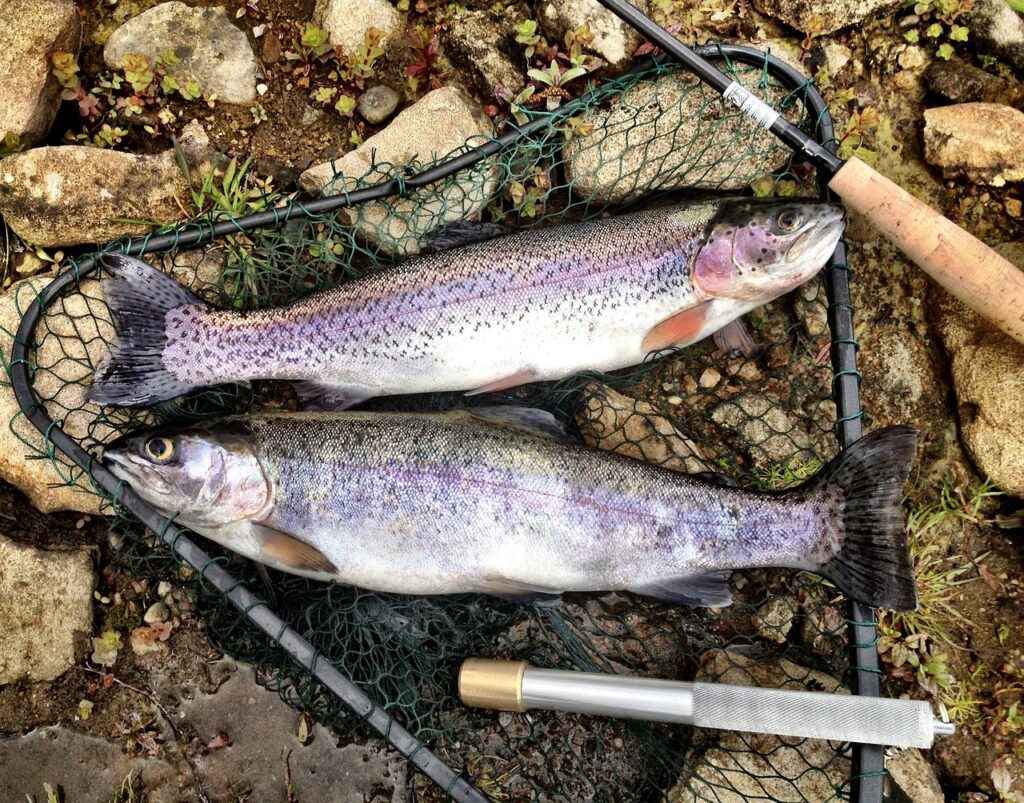Rainbow trout, the vibrant and elusive species of fish, are cherished by anglers around the world for their beauty and spirited fights. Catching a magnificent rainbow trout is an achievement in itself, but preserving that memory forever is an art. In this article, we delve into the world of taxidermy and learn the intricacies of mounting a rainbow trout, transforming it from a fleeting moment into a timeless work of art.

Understanding the Rainbow Trout
Before we embark on the journey of mounting a rainbow trout, it's essential to understand the fish itself. Rainbow trout (Oncorhynchus mykiss) are native to North America, but their popularity has led to their introduction in many other parts of the world. They are famous for their iridescent, rainbow-like colors on their sides, thus earning their name.
Rainbow trout are predominantly freshwater fish, dwelling in clear, cold streams and rivers. They are known for their strong acrobatic displays when hooked, making them a favorite catch for anglers seeking thrilling battles.
Preserving the Memory: An Overview of Taxidermy
Taxidermy, the art of preserving and mounting animals for display, has a long history dating back centuries. Although it serves various scientific and educational purposes, taxidermy also allows people to commemorate their encounters with wildlife in a unique way. Properly preserving a rainbow trout through taxidermy ensures that its vibrant colors and distinctive features are maintained for years to come.
Read More: Lures for Lake Trout
Preparing for the Process of Mounting a Rainbow Trout
Mounting a rainbow trout requires a series of steps that begin immediately after the catch. Time is of the essence to ensure the best results. Once you've reeled in the prized trout, follow these crucial steps:
1. Measure and Photograph:
Take precise measurements of the fish, noting its length and girth. Photograph the fish from multiple angles, capturing its unique patterns and colors. These records will be invaluable during the mounting process.
2. Handle with Care:
Handle the trout with extreme care to avoid damaging its delicate scales and fins. Using a soft, wet cloth can help maintain the fish's moisture and prevent it from drying out.
3. Keep It Cool:
If you're not mounting the fish immediately, store it in a cooler with ice to preserve its freshness. Avoid direct contact between the fish and the ice to prevent freezing.
Choosing the Right Taxidermist for Your Rainbow Trout
Mounting a rainbow trout is a specialized skill that requires the expertise of a skilled taxidermist. When selecting a taxidermist, consider the following factors:
1. Experience and Expertise:
Look for a taxidermist with a proven track record of mounting fish, especially rainbow trout. Ask for samples of their previous work to assess the quality of their craftsmanship.
2. Understanding of Fish Anatomy:
An experienced taxidermist should have a thorough understanding of fish anatomy to ensure accurate and realistic mounting.
3. Customer Reviews:
Check online reviews and testimonials from previous customers to gauge the taxidermist's reputation and customer satisfaction.
The Taxidermy Process: Behind the Scenes of Mounting a Rainbow Trout
Let's delve into the taxidermy process itself, offering an analytical view of each stage:
1. Skinning:
The taxidermist begins by carefully skinning the trout, making incisions along its belly and back. Great precision is required to avoid any damage to the skin, which is crucial for achieving a lifelike mount.
2. Flesh Removal:
After skinning, the flesh and muscle tissue inside the fish are meticulously removed. This process ensures that the fish's skin can be stretched smoothly over the form later on.
3. Mounting Form Selection:
Choosing the right mounting form is crucial to recreate the trout's natural posture accurately. The form, made of foam or other materials, serves as the fish's internal structure.
4. Sculpting and Positioning:
The taxidermist sculpts the mounting form to match the rainbow trout's shape and size. Careful attention is paid to positioning the fins, tail, and mouth in a lifelike manner.
5. Wiring and Drying:
To maintain the fish's shape during the drying process, wires are used to hold the fins and tail in place. The fish is then left to dry completely, which may take several weeks.
6. Detailing and Painting:
Once dry, the trout's skin is reattached to the form. The taxidermist carefully paints the fish, recreating its vibrant colors and patterns with meticulous detail.
7. Finishing Touches:
In the final stage, the taxidermist adds any necessary finishing touches, such as glass eyes and protective coatings, to enhance the mount's realism and longevity.
Caring for Your Rainbow Trout Mount
Congratulations! You now have a stunning rainbow trout mount that will forever preserve the memory of your thrilling catch. To ensure its longevity and beauty, follow these care tips:
1. Display Location:
Choose a display location away from direct sunlight, which can cause the colors to fade over time. Also, avoid placing the mount near heat sources or areas with high humidity.
2. Dusting:
Regularly dust the mount gently with a soft, dry cloth to keep it clean and free from dirt or debris.
3. Avoid Moisture Exposure:
Keep the mount away from water and excessive moisture, as it can damage delicate skin and paintwork.
Looking to mount a rainbow fish at home? Here's how to DIY a rainbow trout mount:
Mounting a rainbow trout at home can be a rewarding project, but it requires careful attention to detail and the right materials. Please note that taxidermy is a skilled and time-consuming process, so it's essential to be patient and follow proper techniques. Here's a general overview of how to mount a rainbow trout at home:
Materials You'll Need:
- Freshly caught rainbow trout
- Taxidermy mounting form (pre-made or DIY foam form)
- Scalpel or sharp knife
- Fleshing tool
- Borax or salt
- Soft, wet cloth
- Wires and needle-nose pliers
- Eye set and adhesive
- Acrylic paints and brushes
- Protective sealant or varnish
Step-by-Step Process:
Preparation
As soon as you catch the rainbow trout, follow these steps to ensure it's ready for the mounting process:
- Measure and photograph the fish from various angles to record its size and colors accurately.
- Gently handle the fish to avoid damaging its scales and fins.
- Keep the fish cool and moist, preferably in a cooler with ice, until you're ready to begin the mounting process.
Skinning and Flesh Removal:
- Lay the trout on a clean, flat surface and make incisions along its belly and back using a scalpel or sharp knife.
- Carefully peel the skin away from the flesh, working slowly and precisely to avoid tearing the skin.
- Remove the flesh and muscle tissue from inside the fish using a fleshing tool, ensuring the skin remains intact.
Mounting Form and Sculpting:
- Choose a taxidermy mounting form that matches the size and shape of the rainbow trout. Alternatively, you can create a DIY foam form based on the measurements you've taken.
- Position the fish's skin over the mounting form, ensuring it fits properly and looks natural.
- Sculpt the foam form to match the fish's body shape, paying attention to positioning the fins, tail, and mouth realistically.
Drying and Wiring:
- To maintain the fish's shape during the drying process, use wires to support the fins and tail. Insert the wires carefully, avoiding damage to the skin.
- Coat the fish skin with borax or salt to help preserve it and remove excess moisture.
Detailing and Painting:
- Insert glass eyes into the eye sockets using eye set adhesive to give the mount a lifelike appearance.
- Apply a protective sealant or varnish over the painted areas to protect the colors and add a glossy finish.
- Check for any final touch-ups needed to enhance the overall realism of the mount.
Safety Precautions:
- When working with sharp tools, such as scalpels or knives, exercise caution to prevent injuries.
- Ensure good ventilation while using paints, adhesives, and sealants to avoid inhalation of fumes.
- Follow all safety guidelines provided by the materials and tools you use.
Conclusion on Mounitng a Rainbow Trout
Mounting a rainbow trout is a labor of love that requires skill, patience, and a genuine appreciation for these magnificent fish. Through the art of taxidermy, anglers can immortalize their prized catch and relive the excitement of the catch for generations to come. Remember to choose a skilled taxidermist, understand the process, and care for your mount properly to preserve its beauty and significance indefinitely. So, the next time you hook a dazzling rainbow trout, consider embracing the art of taxidermy to honor the memory of this remarkable fish forever.
